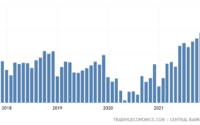Inflation Surge Slashes $11tn From World’s Negative-yielding Debt
This year’s aggressive change of direction by central banks is nearing the end of the era of negative-yielding debt, causing total bonds with a below-zero interest rate to fall by $11 trillion.
Bond prices have fallen this year as central banks end large-scale asset purchases and raise interest rates in their fight against rising inflation, propelling yields in many major economies to their highest levels in years.
As a result, bonds worth $2.7 trillion are currently trading at yields of less than zero, the lowest since 2015, and falling sharply from more than $14 trillion in mid-December, according to the Bloomberg Global Total Bond Index – a broad measure of the fixed income market. Wiping out negative returns completely would mean a return to normalcy for a wide range of large investors.
“Central banks are trying to anticipate this inflation shock too late, so the bond market has abruptly priced in a major shift in interest rates,” said Mike Riddell, senior portfolio manager at Allianz Global Investors.
Negative returns were once considered unthinkable, then as a novelty and later as a permanent feature of global markets. They mean that prices for debt are so high and interest payments so low that if they hold their bonds until maturity, investors are bound to lose money. They reflect the belief that central banks would keep interest rates at rock bottom and have been entrenched in large amounts of debt in Japan and the eurozone in recent years.
That assessment has changed dramatically in recent months, particularly in the euro area, where the European Central Bank reiterated on Thursday that it plans to end its bond-buying program this year, and traders are betting that interest rates will last until December for the first time since 2014.

Putting an end to ultra-low or negative yields is a “double-edged sword” for bond investors, Riddell says. “On the one hand, people bear losses on the bonds they hold. But the flip side is that positive risk-free rates mean that future returns are arguably better looking.” He added that this would be “good news” for investors like pension funds who need to hold large amounts of safe assets like government bonds, but also earn enough returns to cover future payouts.
The dwindling stock of negative-yielding debt also reflects high inflation, which has prompted investors to demand more compensation for rising prices, said Salman Ahmed, global head of macro at Fidelity International.
“Yes, nominal returns are going up, but long-term investors should really care about real returns. It’s what’s left after inflation that counts, and inflation is very high right now,” he said.
The eurozone has been the main driver of the slowdown in debt trading at below-freezing rates. In December, the currency bloc accounted for more than $7 trillion of such bonds, including all German government bonds. That figure has dropped to just $400 billion. Japan, where the central bank has so far resisted the global shift to tighter monetary policy, now accounts for more than 80 percent of the world’s negative-yielding bonds.
Negative yields in the euro area are likely to multiply again unless the ECB pushes through the rate hikes already priced in by the markets. The central bank will struggle to raise interest rates much from their current minus 0.5 percent level given the threat to the region’s recovery from Russia’s invasion of Ukraine and the resulting rise in energy prices, Ahmed said.
“I think the ECB has missed the window to normalize policy, because the growth shock from Ukraine will be much more severe in Europe,” he added. “We don’t think they’re going back to zero this year, and that means negative yielding bonds won’t go away.”
[ad_2]
Source link


